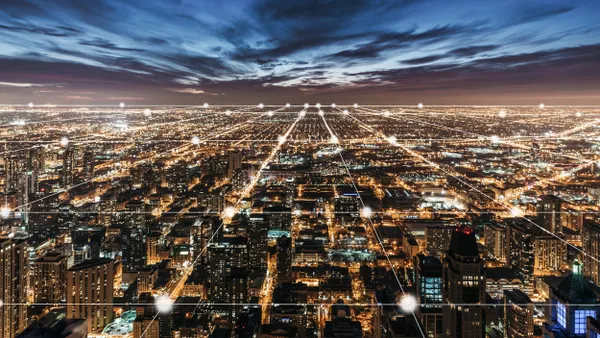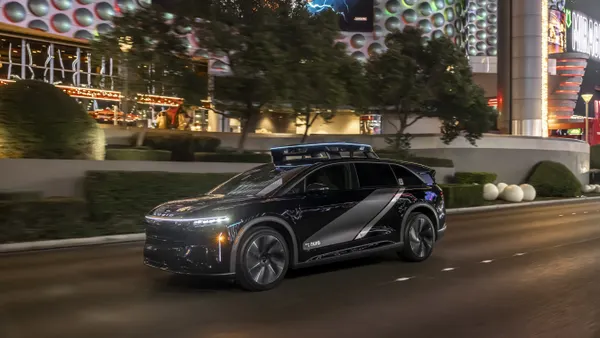Dive Brief:
- Electrify America on Wednesday announced it has completed its first cross-country route, allowing electric vehicle (EV) drivers to travel from Washington, DC to Los Angeles using a direct current fast charger (DCFC) network spanning 11 states and more than 2,700 miles — with charging stations about 70 miles apart, on average.
- Expanded DCFC infrastructure will be vital to growing adoption of EVs, say observers, along with greater availability of longer-range vehicles.
- The Brattle Group anticipates up to 35 million EVs on U.S. roads by 2030, and new analysis from the firm anticipates supporting 20 million will require an investment of $75 billion to $125 billion across the power sector in the next decade.
Dive Insight:
EV drivers looking to go cross country will have two options by the end of summer, according to Electrify America. The company, which runs the largest open DC fast charging network in the U.S., says it is in the process of building out a second route from Jacksonville, FL to San Diego.
Along with east-west routes, Electrify America also offers a major route covering much of the East Coast from Portland, ME to Miami. And on the West Coast, there is a DCFC corridor from Seattle to San Diego.
The company's primary focus "has always been to advance electric vehicle adoption in the U.S., and that starts by instilling feelings of confidence and freedom in consumers when it comes to EV ownership," Anthony Lambkin, director of operations at Electrify America, said in a statement. "The completion of our first cross-country route is a significant step towards that goal."
Along with a new generation of EVs capable of driving farther without the need to recharge, experts say broader availability of DCFC infrastructure is a key to wider adoption of zero-emissions transportation.
Those two factors combined will "make it easy for EV drivers to take long road trips, which some drivers have viewed as a barrier to EV adoption," Plug in America Director of Communications Noah Barnes told Utility Dive. "Increasing availability of charging infrastructure, and particularly DC fast charging, is vital for increasing electric vehicle adoption in the United States."
While "range anxiety" was a common issue early in the rollout of electric vehicles, newer models are approaching the capabilities of traditional gas-fueled cars. According to Consumer Reports, most EVs can now travel more than 200 miles on a single charge. The Tesla Model S and other higher-end models have single-charge ranges around 400 miles.
While the COVID-19 pandemic has slowed sales of electric vehicles, the market is expected to recover. According to Brattle's new analysis, there are about 1.5 million EVs in the United States today — but that number is expected to increase to 10 million to 35 million by 2030, and will require significant utility investment to support.
"While EVs and chargers are becoming more common in our everyday lives, the industry is really just seeing the tip of the iceberg when it comes to the impact that EVs will have on the grid," Brattle Senior Associate Michael Hagerty said in a statement. "System planners across the electricity supply chain need to better understand and prepare for the impacts of EVs, including the opportunities for EV participation in balancing the system."
In the last five years, the number of public EV chargers has increased by about 40% per year, according to Brattle, and that rate must be maintained over the next decade to keep pace with the expected growth in EVs. The group says investment of more than $100 billion could be necessary across the electric power sector supply chain, which would include the addition of 1 million to 2 million public chargers.
Brattle's study anticipates investments of $30 billion to $50 billion for generation and storage to meet higher energy demand and peak loads ; $15 billion to $25 billion for transmission and distribution upgrades; and $30 billion to $50 billion for EV chargers and customer-side infrastructure.
The firm projects a "societal payback" period for the investment of 8.6 years, based on total annual gasoline savings of $12 billion. When avoided greenhouse gas emissions are included in the analysis at $50/ton, the firm said the payback period decreases to 7.2 years.
The buildout will create opportunities and challenges for utilities. Brattle expects the batteries in 20 million EVs will provide up to 1,600 GWh of electricity storage capacity. When technology advances enable two-way power flows and vehicle-to-grid operations, that could mean the ability to send up to 300 GW of power back into the grid to assist with renewable energy integration.
"Transportation electrification poses uncertainties for electric utilities, but also creates opportunities to drive accelerated decarbonization, manage grid reliability, improve asset utilization, and become more customer-centric organizations," Brattle principal Sanem Sergici said.
The firm's new study is focused primarily on light-duty vehicles, but analysts say electrification of commercial fleets and freight trucks "will further magnify electrification-related opportunities."











